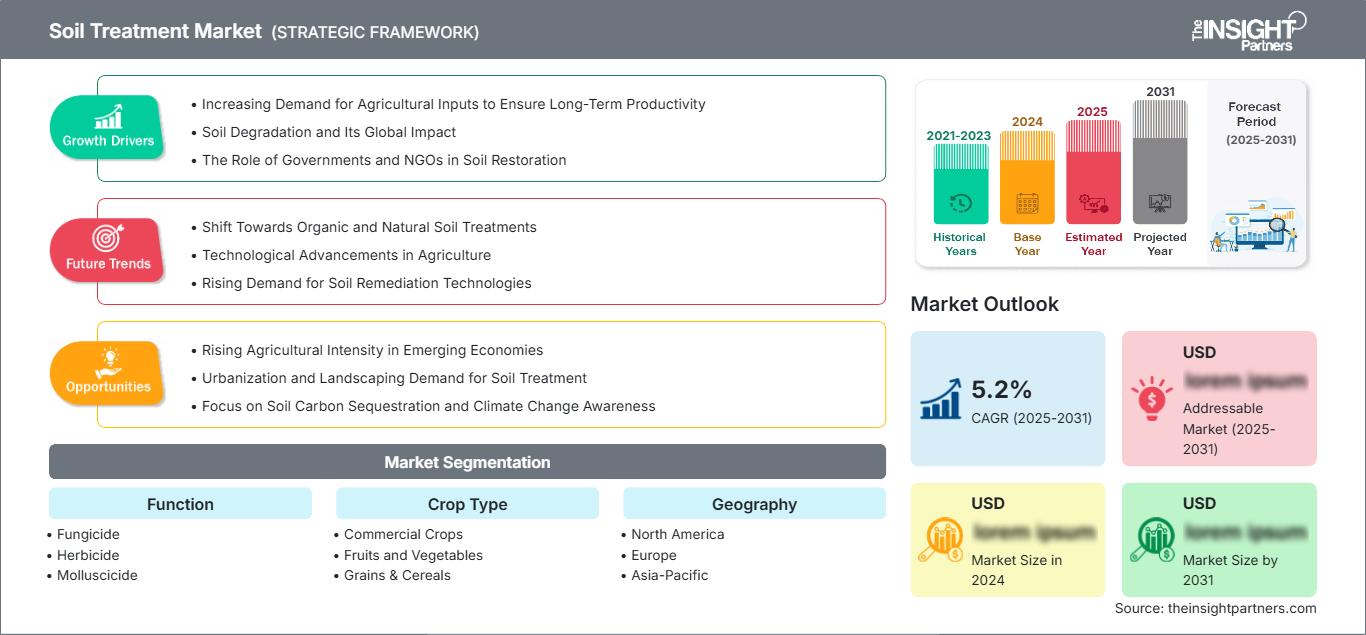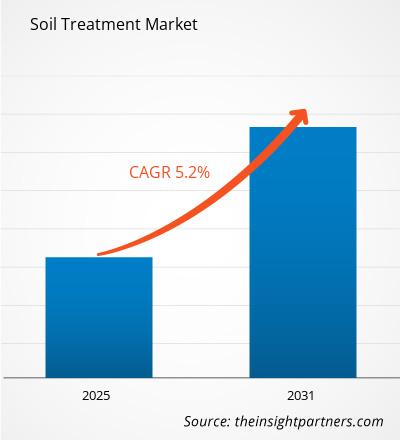Si prevede che il mercato del trattamento del suolo registrerà un CAGR del 5,2% dal 2025 al 2031, con una dimensione del mercato in espansione da XX milioni di dollari nel 2024 a XX milioni di dollari entro il 2031.
Il rapporto è segmentato per funzione (fungicida, erbicida, molluschicida, insetticida e nematocida). Il rapporto presenta inoltre un'analisi basata sul tipo di coltura (colture commerciali, frutta e verdura, cereali, legumi e semi oleosi, tappeti erbosi e piante ornamentali). L'ambito del rapporto copre cinque regioni: Nord America, Europa, Asia-Pacifico, Medio Oriente e Africa, America meridionale e centrale e i paesi chiave di ciascuna regione. L'analisi globale è ulteriormente suddivisa a livello regionale e per paesi principali. Il rapporto offre il valore in USD per l'analisi e i segmenti sopra indicati.
Scopo del rapporto
Il rapporto "Soil Treatment Market" di The Insight Partners mira a descrivere il panorama attuale e la crescita futura, i principali fattori trainanti, le sfide e le opportunità. Ciò fornirà spunti a vari stakeholder aziendali, come:
- Fornitori/produttori di tecnologia: per comprendere le dinamiche di mercato in evoluzione e conoscere le potenziali opportunità di crescita, consentendo loro di prendere decisioni strategiche informate.
- Investitori: per condurre un'analisi completa delle tendenze in merito al tasso di crescita del mercato, alle proiezioni finanziarie di mercato e alle opportunità esistenti lungo la catena del valore.
- Enti di regolamentazione: per regolamentare le politiche e le attività di controllo sul mercato con l'obiettivo di ridurre al minimo gli abusi, preservare la fiducia degli investitori e sostenere l'integrità e la stabilità del mercato.
Funzione di segmentazione del mercato del trattamento del suolo
- Fungicida
- Erbicida
- Molluscicida
- Insetticida
- Nematocida
Tipo di coltura
- Colture commerciali
- Frutta e verdura
- Grani e cereali
- Legumi e semi oleosi
- Tappeti erbosi e ornamentali
Potrai personalizzare gratuitamente qualsiasi rapporto, comprese parti di questo rapporto, o analisi a livello di paese, pacchetto dati Excel, oltre a usufruire di grandi offerte e sconti per start-up e università
Mercato del trattamento del suolo: Approfondimenti strategici

- Ottieni le principali tendenze chiave del mercato di questo rapporto.Questo campione GRATUITO includerà l'analisi dei dati, che vanno dalle tendenze di mercato alle stime e alle previsioni.
Fattori di crescita del mercato del trattamento del suolo
- Crescente domanda di input agricoli per garantire la produttività a lungo termine: con l'aumento della popolazione mondiale, la domanda di prodotti agricoli richiede maggiori input nel suolo per un trattamento adeguato, al fine di garantire la produttività agricola a lungo termine e la disponibilità di una produzione alimentare sostenibile. La fertilizzazione, la regolazione del pH e gli ammendanti organici utilizzati nel trattamento del suolo sono fondamentali in quanto influenzano la salute del suolo e la massimizzazione della resa delle colture, garantendo al contempo la produttività agricola a lungo termine e l'aumento della produzione. Un'elevata produzione agricola richiede una soluzione più efficiente per il suo trattamento.
- Degrado del suolo e il suo impatto globale: l'uso eccessivo di terreni agricoli, la deforestazione, l'industrializzazione e il riscaldamento globale associati al degrado del suolo rappresentano una minaccia per il mondo. Le principali sfide incontrate in questo ambito includono l'erosione del suolo, l'esaurimento dei nutrienti e la contaminazione. Ciò ha richiesto l'adozione di tecniche di condizionamento del suolo, il controllo dell'erosione e la bonifica, aumentando così il ripristino e la conservazione di suoli sani. Governi, ONG e industrie affiliate all'agroindustria hanno interesse a trattare il suolo come mezzo per invertire gli effetti negativi accumulati derivanti da una gestione impropria del suolo.
- Il ruolo dei governi e delle ONG nel ripristino del suolo: la crescente consapevolezza dei fattori ambientali e le severe normative governative in materia di trattamento del suolo con prodotti agricoli sostenibili stanno promuovendo l'adozione di prodotti per il trattamento del suolo. I trattamenti biologici ed ecocompatibili, essendo ecocompatibili, sono la scelta migliore per gli agricoltori, poiché i clienti tendono a ridurre al minimo l'uso di prodotti chimici in agricoltura ed evitare l'inquinamento del suolo e dell'acqua. Le normative agricole richiedono che il trattamento del suolo segua rigorosamente i principi agricoli per un'agricoltura sicura e sana.
Tendenze future del mercato del trattamento del suolo
- Spostamento verso trattamenti del suolo biologici e naturali: i trattamenti del suolo biologici e naturali come compost, biochar e fertilizzanti vegetali sono in crescita. Questo perché i consumatori preferiscono prodotti biologici e le normative ambientali più severe impongono una gestione del suolo non tossica e sostenibile. I trattamenti del suolo a base biologica stanno crescendo anche grazie alla maggiore ecocompatibilità e sicurezza rispetto ai prodotti chimici di sintesi.
- Progressi tecnologici in agricoltura: le nuove tecnologie e la loro adozione in agricoltura stanno modificando il modo in cui il suolo viene trattato. Analisi dei dati, dispositivi IoT, droni e altri sensori stanno dominando la possibilità di praticare l'agricoltura di precisione. Il monitoraggio tempestivo delle condizioni del suolo viene inoltre effettuato con l'ausilio di trattamenti mirati. Queste tecnologie garantiscono che i fertilizzanti del suolo non vengano sprecati, riducendo al minimo gli sprechi e raggiungendo un'efficienza generale ottimale nelle applicazioni di trattamento del suolo. L'impiego di tecnologie più accessibili probabilmente aumenterà la presenza di tali tecnologie nel mercato del trattamento del suolo.
- Crescente domanda di tecnologie di bonifica del suolo: la crescente domanda di tecnologie di bonifica del suolo è innescata dalla contaminazione del suolo con metalli pesanti, pesticidi, rifiuti industriali e altri inquinanti. La domanda in costante aumento di tecnologie di bonifica ecologiche, come la biobonifica e la fitorisanazione per la decontaminazione e il ripristino dei suoli inquinati, ha iniziato a mostrare forza di mercato. Le principali forze trainanti di questa tendenza sono una maggiore consapevolezza ambientale, nuove normative sull'inquinamento industriale e la necessità di terreni puliti e sani per l'agricoltura e le esigenze urbane.
Opportunità di mercato per il trattamento del suolo
- Crescente intensità agricola nelle economie emergenti: la crescente intensità agricola nelle economie emergenti, in particolare Asia-Pacifico, America Latina e Africa, sta aumentando la domanda di tecnologie per il trattamento del suolo. Gli stessi problemi che affliggono queste economie emergenti – pratiche di gestione del suolo inadeguate e sfruttamento eccessivo in molte aree – rappresentano opportunità per le aziende che operano nel settore delle tecnologie per il trattamento del suolo, come ammendanti organici, controllo del pH e ripristino della salute del suolo.
- Domanda di trattamento del suolo per urbanizzazione e paesaggistica: con l'aumento dell'urbanizzazione e della commercializzazione, la necessità di trattamento del suolo nei progetti paesaggistici è in costante aumento. È diventato un requisito essenziale per favorire la crescita delle piante in condizioni urbane difficili, dai parchi urbani ai tetti verdi e ai campi sportivi. Ammendanti, fertilizzanti e materiali per il controllo dell'erosione sono di vitale importanza per la salvaguardia di città sane e sostenibili. Questo, a sua volta, rappresenta una nuova opportunità di sviluppo di mercato per le aziende che trattano il suolo.
- Focus sul sequestro del carbonio nel suolo e sulla consapevolezza dei cambiamenti climatici: insieme alla crescente consapevolezza dei cambiamenti climatici, l'attenzione al sequestro del carbonio nel suolo è in lento ma costante aumento. Tra questi, grandi quantità di biochar, compost e colture di copertura, che sono di conseguenza in grado di migliorare la capacità di cattura e stoccaggio del suolo. Tali metodi stanno ottenendo riconoscimenti come parte di iniziative agricole di più ampia portata che aprono nuove strade per le aziende che sviluppano trattamenti del suolo a supporto degli sforzi di sequestro del carbonio.
Mercato del trattamento del suolo
Le tendenze regionali e i fattori che influenzano il mercato del trattamento del suolo durante il periodo di previsione sono stati ampiamente spiegati dagli analisti di The Insight Partners. Questa sezione illustra anche i segmenti e la geografia del mercato del trattamento del suolo in Nord America, Europa, Asia-Pacifico, Medio Oriente e Africa, America meridionale e centrale.
Ambito del rapporto di mercato sul trattamento del suolo
| Attributo del rapporto | Dettagli |
|---|---|
| Dimensioni del mercato in 2024 | US$ XX million |
| Dimensioni del mercato per 2031 | US$ XX Million |
| CAGR globale (2025 - 2031) | 5.2% |
| Dati storici | 2021-2023 |
| Periodo di previsione | 2025-2031 |
| Segmenti coperti |
By Funzione
|
| Regioni e paesi coperti | Nord America
|
| Leader di mercato e profili aziendali chiave |
|
Densità degli operatori del mercato del trattamento del suolo: comprendere il suo impatto sulle dinamiche aziendali
Il mercato del trattamento del suolo è in rapida crescita, trainato dalla crescente domanda degli utenti finali, dovuta a fattori quali l'evoluzione delle preferenze dei consumatori, i progressi tecnologici e una maggiore consapevolezza dei benefici del prodotto. Con l'aumento della domanda, le aziende stanno ampliando la propria offerta, innovando per soddisfare le esigenze dei consumatori e sfruttando le tendenze emergenti, alimentando ulteriormente la crescita del mercato.

- Ottieni il Mercato del trattamento del suolo Panoramica dei principali attori chiave
Punti di forza
- Copertura completa: il rapporto analizza in modo esaustivo prodotti, servizi, tipologie e utenti finali del mercato del trattamento del suolo, fornendo un panorama olistico.
- Analisi degli esperti: il rapporto è redatto sulla base della conoscenza approfondita di esperti e analisti del settore.
- Informazioni aggiornate: il rapporto garantisce la pertinenza aziendale grazie alla copertura di informazioni e tendenze dei dati recenti.
- Opzioni di personalizzazione: questo rapporto può essere personalizzato per soddisfare le esigenze specifiche del cliente e adattarsi in modo appropriato alle strategie aziendali.
Il rapporto di ricerca sul mercato del trattamento del suolo può quindi contribuire a guidare il percorso di decodificazione e comprensione dello scenario del settore e delle prospettive di crescita. Sebbene possano esserci alcune preoccupazioni valide, i vantaggi complessivi di questo rapporto tendono a superare gli svantaggi.
- Analisi storica (2 anni), anno base, previsione (7 anni) con CAGR
- Analisi PEST e SWOT
- Valore/volume delle dimensioni del mercato - Globale, Regionale, Nazionale
- Industria e panorama competitivo
- Set di dati Excel
Report recenti
Rapporti correlati
Testimonianze
Motivo dell'acquisto
- Processo decisionale informato
- Comprensione delle dinamiche di mercato
- Analisi competitiva
- Analisi dei clienti
- Previsioni di mercato
- Mitigazione del rischio
- Pianificazione strategica
- Giustificazione degli investimenti
- Identificazione dei mercati emergenti
- Miglioramento delle strategie di marketing
- Aumento dell'efficienza operativa
- Allineamento alle tendenze normative




















 Ottieni un campione gratuito per - Mercato del trattamento del suolo
Ottieni un campione gratuito per - Mercato del trattamento del suolo